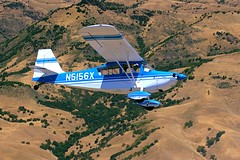 After my last flying adventures, in which I got way more comfortable with my short field landings, I hit the sky again today with an agenda in hand.
After my last flying adventures, in which I got way more comfortable with my short field landings, I hit the sky again today with an agenda in hand.
You see, on Friday I flew with my instructor again and have now received my final signoff for the FAA check ride.
Woohoo! That means it's final practice and cramming time!
On the agenda today was:
- Slow Flight. My goal was to fly along at 50mph, make a few 180 and 360 degree turns, and do so without gaining or losing more than 100 feet.
- Power/Pitch Coordination. I wanted to decelerate from 110 mph to 50 mph without gaining or losing more than 100 feet and then accelerate back to 110 mph.
- Perform at least 2 good soft field landings and takeoffs.
- Make three short field landings and takeoffs.
- Simulate two engine failures while in the pattern and land at a reasonable place on the runway.
- And, just for good measure, one good wheel landing.
The pattern at South County Airport wasn't too crowded and things went quite well. The only negative thing I can say is that my wheel landing wasn't quite "good", but that's okay. Wheel landings are not an exam requirement anyway. There will always be time to practice more. :-)
As a bonus, I even located the electrical problem that's been causing our transponder to work on an intermittent basis. (I used the "whack the electrical panel with fist method...") It's not fixed in a permanent way yet, but at least we know where to look.
If only the oil leak was as easy to track down...
Posted by jzawodn at December 03, 2006 09:28 PM | edit
One suggestion... talk to as many people as you can who did their check rides recently, so that you can find out what sort of things the examiners are doing. I got caught on one that really annoyed all the instructors at the club where I learned to fly. My examiner pulled the engine over Frasier Lake and told me to execute an emergency landing. I flew the pattern south of the runway... he busted me for it because the normal pattern is north, to keep traffic away from Hollister. Everybody I talked to said that was a ridiculous reason to bust me, since it was a simulated emergency. Maybe if you had lots and lots of altitude, but not from where I was... So watch out for that one.
Another one, come to think of it, is Livermore. If you haven't done an approach there on a day when there's a strong wind from the west, it can be educational. On my second ride, when I got my license, the examiner had me do a long straight approach. As we descended through about 800 feet or so, maybe lower, the stall warning suddenly went off and our airspeed was down 10 or 15 knots instantly. It's a very common place for wind shear, in other words, and examiners like to see how you'll handle it. I did fine, of course, or there would have been another check ride! Nose down, get the airspeed, add power to slow descent... I'll bet you have plenty of wind shear experience from sailplanes, though... and you surely didn't develop the bad habit of trying to use power to solve airspeed problems!
You probably already know, but make sure your have all your documents (ARROW) and everything is current or the examiner won't even start the ride.
It would be cool to see a compilation of check ride tips -- I looked online briefly to see if there's any such thing, but didn't find one.
A good short field landing will not be a greaser, but a firm touchdown—the opposite of a soft field landing.
Umm, what's the alternative to a "wheel" landing? Surely you're not going around on skis or floats the rest of the time. Is a "wheel" landing a one-wheel landing? Of what practical use would that be?
If you haven't finished up with the examiner already, good luck with your flight. I've got my CFI checkride tomorrow, provided weather holds, so I'm in a similar boat!
Rob - a wheel landing in a taildragger is when you roll the two main wheels on before settling the tailwheel to the ground. A normal, three-point landing is where you basically plant all three at full stall.
